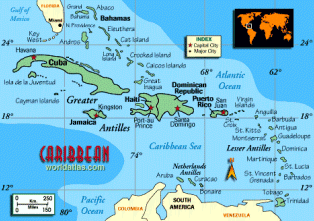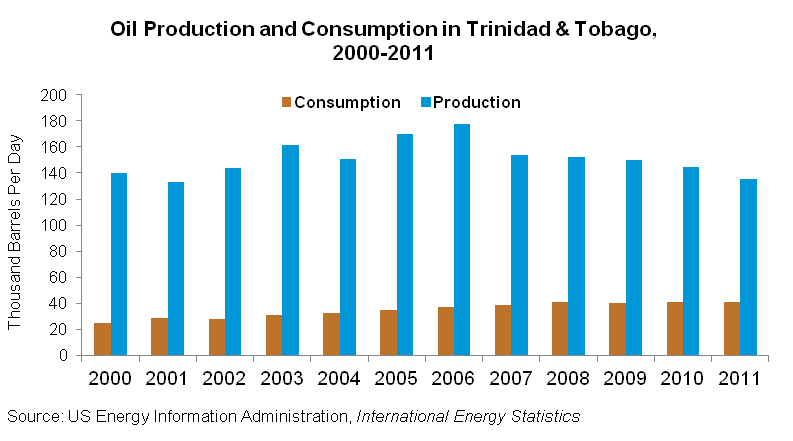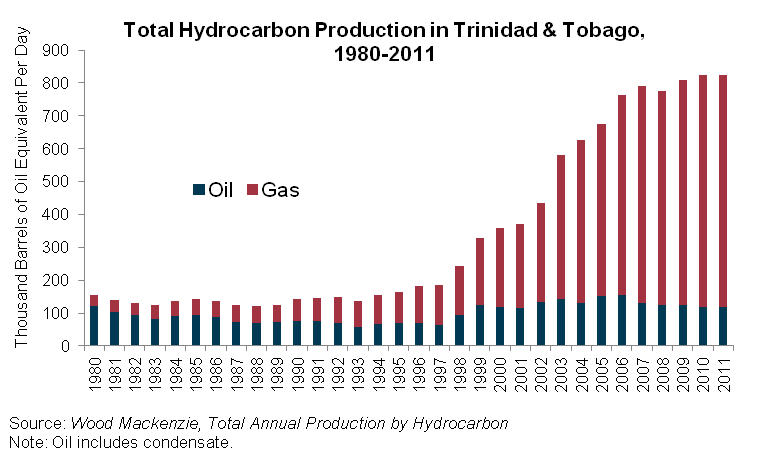‹ Countries
Caribbean
| Download Full Country Analysis BriefLast Updated: May 1, 2012 | |
| Background | |
| Although most Caribbean countries are energy importers, the Caribbean has important centers for oil refining and storage, and Trinidad and Tobago is one of the largest LNG exporters in the world. | The islands of the Caribbean basin are predominantly net energy importers, with the exception of Trinidad and Tobago, which is a major exporter of liquefied natural gas (LNG). Venezuela provides a sizable amount of crude oil and refined products to its Caribbean neighbors at below-market prices and with favorable financing terms under the Petrocaribe initiative. Some islands are important centers for oil refining and storage, due to their proximity to the U.S. market.
 In recent years, there has been concern that higher global oil prices will impair the Caribbean economies, as they are highly dependent upon oil for their energy needs. In response, the island nations have been discussing ways to promote alternative energy sources and better integrate their energy sectors.
|
| Oil Production | |
| Caribbean countries are net oil importers, with the exception of Trinidad and Tobago. Oil exploration has received considerable interest in Cuba's offshore basins, especially in the Gulf of Mexico. | Trinidad and Tobago contains the majority of the Caribbean's oil production. Most of the oil production and exploration is focused offshore, but the government has been encouraging field development onshore as well. In 2011, the country produced 135,000 barrels per day (bbl/d) of oil, of which 92,000 bbl/d was crude oil including lease condensate and the remainder mostly consisted of natural gas liquids (NGLs). Oil production had been falling in the 1980s and 1990s, but was bolstered a decade later when BHP Billiton's offshore Angostura oil and gas field came online in January 2005. Large oil producers include the state-owned Petroleum Company of Trinidad and Tobago (Petrotrin), BP Trinidad and Tobago and BHP Billiton.
For the past five years oil production has been steadily declining. In 2006, oil output reached nearly 178,000 bbl/d, but production has fallen below the country's expectation to produce 200,000 bbl/d of crude. The recent fall in output has been attributed to maturing oil fields and operational challenges faced by some of the country's largest producers, according to Global Insight.
 Oil consumption in the country is moderate, allowing the country to export a sizable amount of its production. EIA data shows that the United States has been the primary destination, with 76,000 bbl/d of crude oil and refined products exported to the United States in 2011. Trinidad and Tobago consumed an estimated 40,000 bbl/d of oil in 2011. The country also imports small amounts of crude oil and refined products.
CubaCuba produced about 55,000 bbl/d of oil in 2011, while consuming just over 170,000 bbl/d, making the island a net oil importer. Most of this comes from Venezuela via its Energy Agreement with Cuba, signed in October 2000. Cuba's oil production has increased in the past two decades, from 13,000 bbl/d in 1988. Most of Cuba's oil production occurs in the northern Matanzas province, producing a heavy, sour crude that requires specific processing. Much of this production occurs onshore, though there is some offshore production in shallow coastal waters. Cuba's oil production seems to have largely stabilized in the near term, with any additional increases in production dependent upon the discovery of substantial new reserves (see below).
Offshore ExplorationThere has been considerable interest in exploration activities in Cuba's offshore basins, especially in the Gulf of Mexico. The U.S. Geological Survey (USGS) mean estimate for undiscovered oil reserves in the North Cuba Basin (the basin north and west of the island in the Gulf of Mexico) is 4.6 billion barrels. Cubapetroleo, or Cupet (Cuba's state-owned petroleum company) estimates that all of Cuba's offshore basins could contain in excess of 20 billion barrels of undiscovered oil reserves. However, actual exploratory drilling in the area has been, to date, quite limited. In 2011, companies operating in Cuba reported that they plan to drill five exploration wells in ultra-deep waters of the exclusive economic zone (EEZ) in the Gulf of Mexico, according to Global Insight. Early this year, Repsol began drilling an exploration well located on Block N26 in Cuba's EEZ.
|
| Downstream | |
| The Caribbean has several export-oriented oil refineries and storage centers, geared mainly towards the U.S. market. However, two major refineries were recently closed after experiencing losses due to changes in global demand and competition from new refineries elsewhere. | According to estimates from Bloomberg and Oil and Gas Journal (OGJ), the Caribbean region has a combined 1.6 million bbl/d of nominal nameplate refining capacity. Smaller refineries mostly produce petroleum products for local demand, whereas the larger facilities are geared towards exports to the United States and other markets. Recently, major refineries in the region have found it difficult to compete with new refineries in emerging markets and U.S. refineries powered by cheaper domestically produced natural gas. As a result, two of the largest refineries have shut down in 2012, reducing actual operating capacity by almost 40 percent to about 1 million bbl/d.
Major Oil Refineries in the Caribbean
 In February 2012, Hovensa LLC, a joint venture of PdVSA and Hess Corp., shut down its U.S. Virgin Islands refinery, which was operating at 350,000 bbl/d, down from its previous level of 500,000 bbl/d. The site has oil storage tanks with a capacity to store 32 million barrels and it will continue to be used as a storage terminal, according to Bloomberg. Over the past three years, losses at the refinery totaled $1.3 billion and were expected to continue, according to Hovensa. The reasons for losses and the eventual shut down include: weaker global demand for products; new refining capacity in emerging markets; and since Hovensa is an oil-fueled refinery, the relatively low price and abundance of natural gas in the U.S. had placed Hovensa at a competitive disadvantage to U.S. refineries. Prior to its shut down, the Hovensa refinery had obtained a bulk of its crude supplies from Venezuela and sent most of its refined output to the United States.
This year Valero Energy announced it would shutdown its refinery in Aruba due to low refinery margins by the end of March 2012. The facility may now still be used as a storage terminal and will remain in a state that would allow refining operations to restart in the future. Like Hovensa, Valero executives claimed that the refinery was at a disadvantage to U.S. refineries that have easy access to relatively cheaper natural gas to power operations. The Aruba refinery had previously been closed in 2009 because of poor margins, but had restarted production in early 2011. Prior to the recent shutdown, the refinery was operating at a reduced rate while processing heavy sourcrude oil into gasoline, heating oil and feedstock components tomake finished fuel to the U.S. Gulf Coast, the New York Harbor,the Caribbean, South America and Europe, according to Reuters.
The Caribbean is also an important storage location, particularly for crude oil brought in from outside the region. The region has been traditionally viewed as an advantageous storage site since the islands rest between the Americas and sites are in close proximity to transport and refining centers.
In March 2012, Hess Corporation announced that it is considering the sale of its storage and transshipment terminal in St. Lucia, which has a storage capacity of 10 million barrels. The announcement came shortly after Hess revealed the decision to shut down the Hovensa refinery. According to a St. Lucia government official, Hess has said it would continue storage operations on the island if they do not get a favorable sale.
Major Oil Storage Centers in the Caribbean
 Many of the Caribbean countries import oil from Mexico and Venezuela under favorable terms. Under the San Jose Pact, Barbados, the Dominican Republic, Haiti, and Jamaica receive oil and refined products from those two countries. Cuba also receives crude oil and petroleum products from Venezuela at a discounted rate. In 2005, nearly all Caribbean countries signed the Venezuela-backed Petrocaribe initiative. Under the program, Venezuela sells crude oil and refined products to these countries under favorable financing terms.
Exports to U.S.The United States imported 14 percent of its refined product imports from the Caribbean, or 340,000 bbl/d in 2011. The share of U.S. total petroleum product imports from the region has declined by about 5 percent from the start of the decade, as it was 17 percent in 2000. The reduction in the quantity of imports from the region is largely the result of the decline in U.S. petroleum demand following the recession that began at the end of 2007.
 |
| Natural Gas | |
| Trinidad and Tobago is the largest exporter of liquefied natural gas to the United States, and the fifth largest in the world. | Trinidad and Tobago In the early 1990s, the hydrocarbon sector in Trinidad and Tobago transitioned from being oil dominant to a predominantly natural gas-based sector. Natural gas production currently accounts for just over 85 percent of the country's natural resource base. The construction of the country's first LNG train in the 1990s and its completion in 1999 facilitated the increase in natural gas production.
 Since the Train I LNG facility began to operate in 1999, natural gas production in Trinidad and Tobago has climbed dramatically. In 2010, the country produced 1.5 trillion cubic feet (Tcf) of natural gas, over three times the level seen in 2000. Domestic consumption of natural gas has steadily increased as well, as domestic demand is supported by government subsidies. Consumption grew to 780 billion cubic feet (Bcf) in 2010, just over double the level at the start of the decade.
 The country has benefited from substantial foreign investments, with BP Trinidad and Tobago (BPTT) accounting for almost 60 percent of the country's natural gas production. British Gas is the second leading player in the industry, operating nearly a quarter of the natural gas production in the country. National companies participate in the sector as small shareholders in operations.
Despite the sector's recent success, the lack of new discoveries coupled with rapid production has led to a sharp decline in proven reserves. In the span of only five years, proven natural gas reserves have declined sharply by over 50 percent, from 25.9 Tcf in 2006 to 14.4 Tcf in 2011, according to Oil & Gas Journal as of January 1, 2012. According to PFC Energy, the country may not be able to sustain current output levels through the end of the decade.
 Source: Oil and Gas Journal
Liquefied Natural Gas Trinidad and Tobago is the largest supplier of LNG to the United States, and the fifth largest exporter in the world after Qatar, Indonesia, Malaysia, and Australia, according to FACTS Global Energy 2010 figures. EIA data shows that Trinidad and Tobago exported 129 Bcf of natural gas to the United States in 2011, about 37 percent of total U.S. LNG net imports, but less than 1 percent of total U.S. natural gas supply. In the last five years, U.S. LNG imports from Trindad and Tobago have declined by almost one-third, which reflects the general decline in total U.S. LNG imports.
 The Atlantic LNG Company, a consortium led by BP, BG, GDF Suez, and the former Repsol-YPF, operates four LNG trains at Point Fortin, on the south-western coast of Trinidad. The first LNG train was completed in March 1999, with subsequent trains completed in 2002, 2003, and 2006. The four trains have capacity to produce a combined 14.8 million metric tons (Mmt) of LNG per year (775 Bcf of re-gasified natural gas). Atlantic LNG and the government of Trinidad and Tobago have indicated that there may be a fifth and sixth train, though currently there are official plans as of yet to pursue these projects. Trinidad and Tobago also has a substantial petrochemical industry to further monetize natural gas reserves.
|
| Links | |
| EIA Links EIA Country Energy Profiles U.S. Government U.S. Census Bureau U.S. State Department Information on Caribbean Countries Associations and Institutions BBC News - Curacao CARICOM - The Caribbean Community Official Home Page of the Free Trade Area of the Americas The Organization of American States The Organization of Eastern Caribbean States Foreign Government Agencies Ministry of Energy and Energy Affairs (Trinidad and Tobago) |
|
| Sources | |
| AES Associated Press Atlantic LNG Bloomberg Business News Americas CIA World Factbook Dow Jones Financial Times Hovensa LLC IHS Cera /Global Insight Jamaica Observor New York Times Oil and Gas Journal Oil Daily Offshore Petroleum Economist Petroleum Intelligence Weekly PFC Energy Platts Oilgram News Reuters TankTerminals.com The Caribbean Journal UPI U.S. Energy Information Administration U.S. Federal Energy Regulatory Commission World Gas Intelligence |
|
| Contact Info | |
| cabs@eia.gov (202)586-8800 cabs@eia.gov |
|
